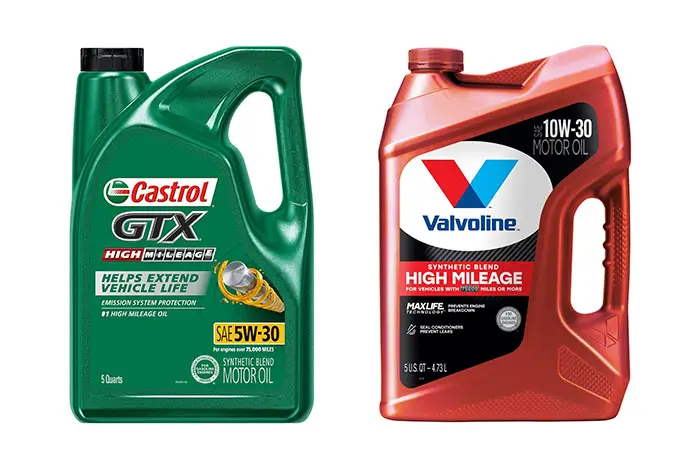Buying oil can be confusing, especially when you see all the different numbers on the containers. Some of the most common types of oil include 5W30 and 10W30. In some ways, these oils are exactly the same. However, in other ways, they are very different. Using the wrong engine oil could lead to damage to your vehicle’s motor, so you want to make sure you fully understand the difference between 5W30 and 10W30 and know which one to use.
Keep reading as we explain the significant difference between 5W10 oil and 10W30 oil. We’ll also tell you what the numbers mean and which one you should use in your vehicle. Here are all the details you need to know.
5W30 vs. 10W30 Engine Oil: What’s The Difference?
To understand the difference between these two types of motor oil, you first need to understand what the numbers mean. The numbers associated with engine oil describe their viscosity or thickness. You might be wondering why there are two numbers in this case. When you see two numbers on oil, it means that the oil is a multi-grade oil. We will discuss multi-grade oil in more detail later in this article. However, for now, know that multi-grade oil has one viscosity at low temperatures and a different viscosity at high temperatures. The thickness of the oil changes as the temperature of the oil increases.
The only real difference between 5W30 and 10W30 oil is the thickness of the oil at lower temperatures. 10W30 oil is thicker and has a higher viscosity than 5W30 when it is cold, but both oils will have the same thickness and viscosity once the engine reaches operating temperature. Thicker oil will provide better lubrication, and this can be especially important in older vehicles or cold climates. There are some tradeoffs associated with thicker oil, though.
Lower viscosity oil typically leads to increased fuel economy and slightly more horsepower because it creates less drag on internal engine components. These tradeoffs are usually not as much of an issue with 5W30 vs. 10W30 because the oil does not stay at a low temperature very long once the engine has been started. However, the different thicknesses at operating temperature can make a big difference, such as when comparing 5W20 vs. 5W30 oil or even 10W30 vs. 10W40 oil.
Motor Oil Viscosity Explained

So, what does viscosity mean? Is it simply the thickness of the oil? Viscosity not only describes the thickness of the oil but also points to how easily the oil will flow. For instance, water has a very low viscosity. It is thin, and it flows easily. However, honey or syrup has a high viscosity. Honey is thick, and it does not flow easily. The Society of Automotive Engineers (SAE) has set standards for viscosity ratings. Using these standards, you can quickly compare different types of oil – even between different brands. For example, an oil with a viscosity rating of 20 will always be the same thickness, regardless of the brand or manufacturer.
Similarly, the viscosity of conventional oil and synthetic oil might be the same, but the composition of the oil itself is different. Conventional oil is made from crude oil through the refining process. Synthetic oil is still made from natural materials, but it has undergone a chemical process that removes impurities and ensures the molecules are uniform in size. Synthetic oil can withstand extremely hot temperatures, and synthetic oil also performs well under a heavy load.
Single Grade vs. Multigrade Engine Oil — What Do The Numbers Mean?
You might notice that some oils have only one number, while others have two numbers on them. What is the difference, and what do the numbers mean? If oil has only one number, the viscosity of the oil remains the same regardless of the temperature. This is called a single-grade oil. This type of oil is usually used in small engines, like lawnmowers. Most small engines use SAE 30 oil, and the viscosity of the oil remains at 30 at all times.
However, when you see two numbers, the oil is considered a multi-grade oil. The first number refers to the cold weather viscosity or the winter viscosity of the oil. Hence, the ‘W’ after the number. This describes the thickness of the oil at low temperatures or at engine startup.
The second number refers to the thickness of the oil at high temperatures or at the operating temperature of the engine. Multi-grade oil becomes thicker at higher temperatures because the polymers in the oil expand. This increases the thickness of the oil, and it increases the amount of lubrication the oil provides. Thinner oils, on the other hand, create less drag on the internal components of the engine. Thinner oil can also increase fuel economy and horsepower.
You might notice that you are seeing lower and lower numbers on today’s multi-grade oil. Some multi-grade oils even have a cold temperature viscosity of zero. The reason for this is that modern engines have extremely small tolerances and clearance of internal parts. Thin oil is necessary for these tight clearances. On the other hand, older engines have higher tolerances, and thicker oil is needed to lubricate the engine parts.
Can You Mix 5W30 & 10W30 Engine Oil?
You might be wondering whether you can mix 5W30 and 10W30 oil. The short answer is yes, but there are some things you should be aware of before mixing the two viscosity grades. First, make sure that your vehicle can use either type of oil. If your car is not capable of handling the cold thickness of 10W30, then it should not be mixed. However, if your car can handle either grade, combining the two oils should have no negative consequences.
Next, always try to use the same brand if you mix different oil types. Different brands may have different additives, and some additives might not mix well with others. Sticking with the same brand will help ensure that this type of conflict does not arise.
Finally, if you are in an emergency situation and have no other choice but to mix 5W30 motor oil and 10W30 motor oil, go ahead and do so. Mixing a small amount of a different type of oil should not lead to immediate damage, and even the wrong weight of oil in your engine will be better than too little oil. However, make sure that you perform an oil change as soon as possible. This will allow you to drain the mixed oil from your car engine and replace it with the right oil for your car.
Best Oil Viscosity For High Mileage Vehicles

Many people believe that a higher viscosity oil is better for high-mileage vehicles, although this is not always the case. You should refer to your owner’s manual for the proper oil viscosity for your car, and you should always follow the manufacturer’s recommendation found in the manual. However, there are high-mileage oils available that contain special additives aimed to help reduce engine wear in high-mileage cars.
These high-mileage engine oils contain additives that will help condition and restore seals and gaskets. In addition, they help reduce sludge and burnoff and can help eliminate carbon deposits in your engine. Sticking with the proper oil grade for your engine is crucial to keeping your oil pressure in the proper range and keeping the parts of the engine properly lubricated. Here are some of the best high-mileage oils available.
First, the Castrol GTX High-Mileage 5W-30 Synthetic Blend is a great option for those with over 75,000 miles on their vehicle. This oil blends both conventional and synthetic oil for superior burnoff protection and better sealing of the gaskets and seals within the engine. Next, the Valvoline High-Mileage 10W-30 with MaxLife Technology oil is another great option. This product from Valvoline is also a synthetic blend that can help prevent leaks and reduce sludge buildup. Both of these products are available from Amazon and other retailers.
The Bottom Line
The difference between 5W30 oil and 10W30 oil is the viscosity of the oil at cold temperatures. Low viscosity oil is thinner, while a higher viscosity oil is thicker. 5W30 will be thinner at startup than 10W30, although both oils will have the same thickness at your engine’s operating temperature — around 200 degrees Fahrenheit. So, can you use 10W30 instead of 5W30? You should avoid using the wrong type of oil in your car’s engine. Make sure that you always use the oil recommended in your owner’s manual, and mixing different types should generally be avoided.
Frequently Asked Questions
Is it OK to use 10W30 instead of 5W30?
You might be wondering, “Can I use 10W30 instead of 5W30?” If your vehicle requires 5W30, you should not use 10W30 instead. Using the wrong type of oil could lead to engine damage in extreme cases. If you need to mix different types of oils in an emergency, that is generally OK. However, you should perform an oil change as soon as you can so that you can refill your engine with the right type of oil. Although there is not a huge difference between 5W30 and 10W30, you should stick with the type recommended by your manufacturer.
Is 10W30 or 5W30 better for winter?
The answer depends on your specific vehicle. 10W30 will be thicker at startup than 5W30, especially in colder climates. Your engine might not be designed to handle a thicker oil upon startup. As the temperature range increases, the thickness of the two oils becomes identical. Once your engine reaches operating temperature, there is no difference between 10W30 and 5W30. Therefore, you should stick with the oil type specified in your owner’s manual during winter, even if you live in a cold climate.
Is 10W30 better for high mileage?
Some people believe that a slightly thicker oil is better for high-mileage engines, so 10W30 would be better in that case. However, the additives in the oil generally are more important than the thickness when it comes to high-mileage applications. You should stick with the viscosity recommended for your vehicle but opt for oil designed explicitly for high-mileage cars. This type of oil will contain special additives that help reduce sludge and condition old seals and gaskets.
What are the pros and cons to 10W30?
One of the biggest pros to 10W30 is that the oil is thicker at startup, thus providing better lubrication to the internal engine parts. However, this increased lubrication comes with a tradeoff. More viscous oil also creates more drag on engine parts and leads to decreased fuel economy and horsepower. Similarly, most modern engines have extremely small tolerances. Therefore, these engines need a thin oil to fit inside those spaces and reduce metal contact.

